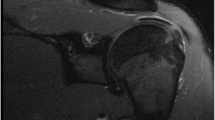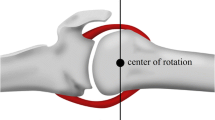Abstract
The aim of this study was to compare the mechanical behavior under cyclic loading test of single-row and double-row rotator cuff repair with suture anchors in an ex-vivo animal model. For the present study, 50 fresh porcine shoulders were used. On each shoulder, a crescent-shaped full-thickness tear of the infraspinatus was performed. Width of the tendon tear was 2 cm. The lesion was repaired using metal suture anchors. Shoulders were divided in four groups, according the type of repair: single-row tension-free repair (Group 1); single-row tension repair (Group 2); double-row tension-free repair (Group 3); double-row tension repair (Group 4); and a control group. Specimens were subjected to a cyclic loading test. Number of cycles at 5 mm of elongation and at failure, and total elongation were calculated. Single-row tension repair showed significantly poorest results for all the variables considered, when compared with the other groups. Regarding the mean number of cycles at 5 mm of elongation and at failure, there was a nonsignificant difference between Groups 3 and 4, and both of them were significantly greater than Group 1. For mean total elongation, the difference between Groups 1, 3, and 4 was not significant, but all of them were significantly lower than the control group. A single-row repair is particularly weak when performed under tension. Double-row repair is significantly more resistant to cyclic displacement than single-row repair in both tension-free and tension repair. Double-row repair technique can be primarily considered for large, unstable rotator cuff tears to improve mechanical strength of primary fixation of tendons to bone.


Similar content being viewed by others
References
Abbi G, Espinoza L, Odell T, Mahar A, Pedowitz R (2006) Evaluation of 5 knots and 2 suture materials for arthroscopic rotator cuff repair: very strong sutures can still slip. Arthroscopy 22:38–43
Apreleva M, Ozbaydar M, Fitzgibbons PG, Warner JJ (2002) Rotator cuff tears: the effect of the reconstruction method on three-dimensional repair site area. Arthroscopy 18:519–526
Buess E, Steuber KU, Waibl B (2005) Open versus arthroscopic rotator cuff repair: a comparative view of 96 cases. Arthroscopy 21:597–604
Burkhart SS, Esch JC, Jolson RS (1993) The rotator crescent and rotator cable: An anatomic description of the shoulder’s “suspension bridge.”. Arthroscopy 9:611–616
Cummins CA, Appleyard RC, Strickland S, Haen PS, Chen S, Murrell GA (2005) Rotator cuff repair: an ex vivo analysis of suture anchor repair techniques on initial load to failure. Arthroscopy 21:1236–1241
De Carli A, Vadala A, Monaco E, Labianca L, Zanzotto E, Ferretti A (2005) Effect of cyclic loading on new polyblend suture coupled with different anchors. Am J Sports Med 33:214–219
Demirhan M, Atalar AC, Kilicoglu O (2003) Primary fixation strength of rotator cuff repair techniques: a comparative study. Arthroscopy 19:572–576
Dugas JR, Campbell DA, Warren RF, Robie BH, Millett PJ (2002) Anatomy and dimensions of rotator cuff insertions. J Shoulder Elbow Surg 11:498–503
Fealy S, Kingham TP, Altchek DW (2002) Mini-open rotator cuff repair using a two-row fixation technique: outcomes analysis in patients with small, moderate, and large rotator cuff tears. Arthroscopy 18:665–670
Galatz LM, Ball CM, Teefey SA, Middleton WD, Yamaguchi K (2004) The outcome and repair integrity of completely arthroscopically repaired large and massive rotator cuff tears. J Bone Joint Surg Am 86:219–224
Goutallier D, Postel JM, Gleyze P, Leguilloux P, Van Driessche S (2003) Influence of cuff muscle fatty degeneration on anatomic and functional outcomes after simple suture of full-thickness tears. J Shoulder Elbow Surg 12:550–554
Halder AM, O’Driscoll SW, Heers G, Mura N, Zobitz ME, An KN, Kreusch-Brinker R (2002) Biomechanical comparison of effects of supraspinatus tendon detachments, tendon defects, and muscle retractions. J Bone Joint Surg Am 84:780–785
Harryman DT II, Mack LA, Wang KY, Jackins SE, Richardson ML, Matsen FA III (1991) Repairs of the rotator cuff: correlation of functional results with integrity of the cuff. J Bone Joint Surg Am 73:982–989
Ide J, Maeda S, Takagi K (2005) A comparison of arthroscopic and open rotator cuff repair. Arthroscopy 21:1090–1098
Jost B, Zumstein M, Pfirrmann CW, Gerber C (2006) Long-term outcome after structural failure of rotator cuff repairs. J Bone Joint Surg Am 88:472–479
Kim DH, Elattrache NS, Tibone JE, Jun BJ, DeLaMora SN, Kvitne RS, Lee TQ (2006) Biomechanical comparison of a single-row versus double-row suture anchor technique for rotator cuff repair. Am J Sports Med 34:407–414
Liu SH, Baker CL (1994) Arthroscopically assisted rotator cuff repair: correlation of functional results with integrity of the cuff. Arthroscopy 10:54–60
Lo IK, Burkhart SS (2004) Arthroscopic repair of massive, contracted, immobile, rotator cuff tears using single and double interval slides: technique and preliminary results. Arthroscopy 20:22–33
Lo IKY, Burkhart SS (2003) Double-row arthroscopic rotator cuff repair: re-establishing the footprint of the rotator cuff. Arthroscopy 19:1035–1072
Ma CB, Comerford L, Wilson J, Puttlitz CM (2006) Biomechanical evaluation of arthroscopic rotator cuff repairs: double-row compared with single-row fixation. J Bone Joint Surg Am 88:403–410
Ma CB, MacGillivray JD, Clabeaux J, Lee S, Otis JC (2004) Biomechanical evaluation of arthroscopic rotator cuff stitches. J Bone Joint Surg Am 86:1211–1216
Martin RB, Burr DB, Sharkey NA (1998) Skeletal tissue mechanics. Springer, New York
Mazzocca AD, Millett PJ, Guanche CA, Santangelo SA, Arciero RA (2005) Arthroscopic single-row versus double-row suture anchor rotator cuff repair. Am J Sports Med 33:1861–1868
Meier SW, Meier JD (2006) Rotator cuff repair: the effect of double-row fixation on three-dimensional repair site. J Shoulder Elbow Surg 15:691–696
Meyer DC, Fucentese SF, Koller B, Gerber C (2004) Association of osteopenia of the humeral head with full-thickness rotator cuff tears. J Shoulder Elbow Surg 13:333–337
Roddey TS, Cook KF, O’Malley KJ, Gartsman GM (2005) The relationship among strength and mobility measures and self-report outcome scores in persons after rotator cuff repair surgery: impairment measures are not enough. J Shoulder Elbow Surg 14(1 Suppl):95S–98S
Ruotolo C, Fow JE, Nottage WM (2004) The supraspinatus footprint: an anatomic study of the supraspinatus insertion. Arthroscopy 20:246–249
Schneeberger AG, von Roll A, Kalberer F, Jacob HA, Gerber C (2002) Mechanical strength of arthroscopic rotator cuff repair techniques: an in vitro study. J Bone Joint Surg Am 84:2152–2160
Severud EL, Ruotolo C, Abbott DD, Nottage WM (2003) All-arthroscopic versus mini-open rotator cuff repair: a long-term retrospective outcome comparison. Arthroscopy 19:234–238
Sugaya H, Maeda K, Matsuki K, Moriishi J (2005) Functional and structural outcome after arthroscopic full-thickness rotator cuff repair: single-row versus dual-row fixation. Arthroscopy 21:1307–1316
Tauro JC (1999) Arthroscopic “interval slide” in the repair of large rotator cuff tears. Arthroscopy 15: 527–530
Thomazeau H, Boukobza E, Morcet N, Chaperon J, Langlais F (1997) Prediction of rotator cuff repair results by magnetic resonance imaging. Clin Orthop Relat Res 344:275–283
Tuoheti Y, Itoi E, Yamamoto N, Seki N, Abe H, Minagawa H, Okada K, Shimada Y (2005) Contact area, contact pressure, and pressure patterns of the tendon-bone interface after rotator cuff repair. Am J Sports Med 33:1869–1874
Waltrip RL, Zheng N, Dugas JR, Andrews JR (2003) Rotator cuff repair: a biomechanical comparison of three techniques. Am J Sports Med 31:493–497
Warner JJ, Tetreault P, Lehtinen J, Zurakowski D (2005) Arthroscopic versus mini-open rotator cuff repair: a cohort comparison study. Arthroscopy 21:328–332
Author information
Authors and Affiliations
Corresponding author
Rights and permissions
About this article
Cite this article
Milano, G., Grasso, A., Zarelli, D. et al. Comparison between single-row and double-row rotator cuff repair: a biomechanical study. Knee Surg Sports Traumatol Arthr 16, 75–80 (2008). https://doi.org/10.1007/s00167-007-0382-0
Received:
Accepted:
Published:
Issue Date:
DOI: https://doi.org/10.1007/s00167-007-0382-0




